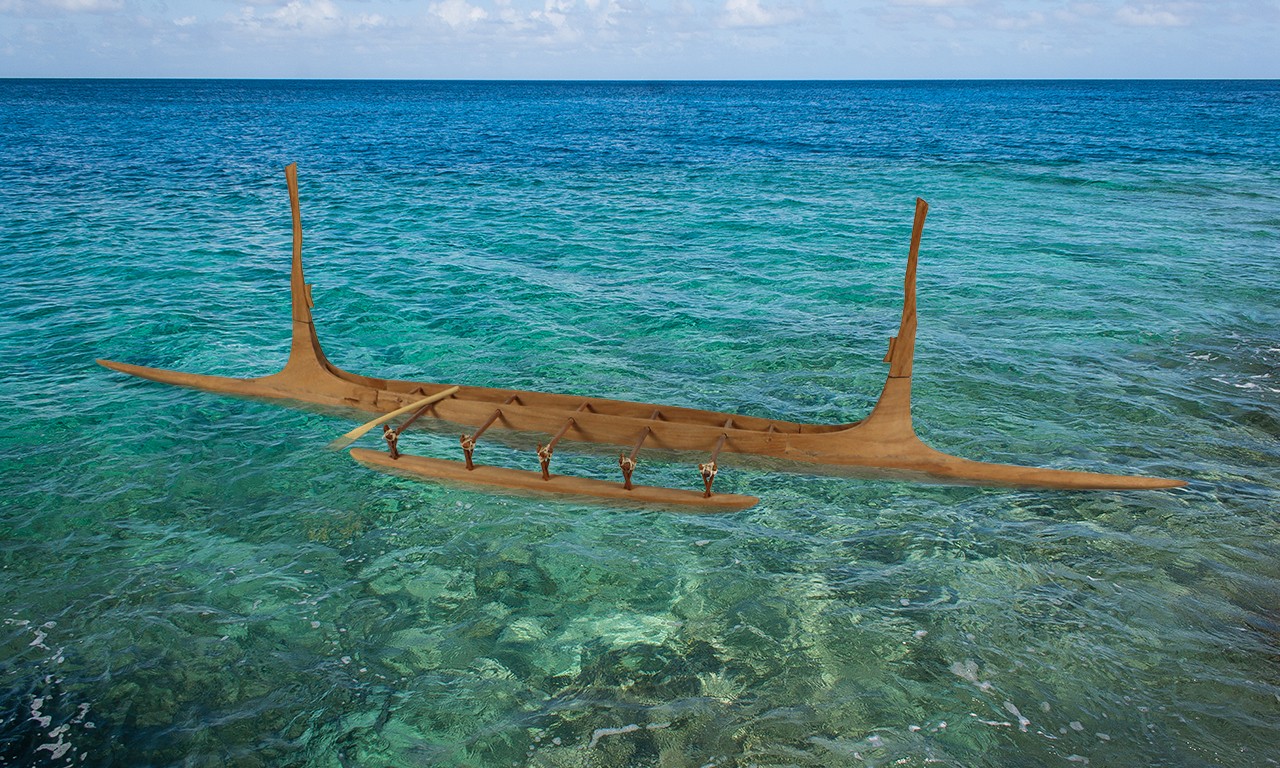 |
Artist rendering of a model canoe from Wuvulu (2021.7.49a,b) enlarged and in the ocean
Anonymous Gift |
Close but Far Away
Maps of Oceania are often split into distinct cultural subregions, but there is a surprising amount of overlap between Melanesia, Micronesia, and Polynesia. Despite being only 100 miles away from the coast of New Guinea, the center of Melanesian culture, the island of Wuvulu—formerly named Maty Island after Matthew Maty, the second principal librarian of the British Museum—is culturally Micronesian. As a result, the unique functional and decorative objects produced on the island show influences from both Melanesia and Micronesia. In this post, we look at a selection of objects from Wuvulu that will soon be going on display in the Bowers Museum’s Spirits and Headhunters: Art of the Pacific Islands exhibition.

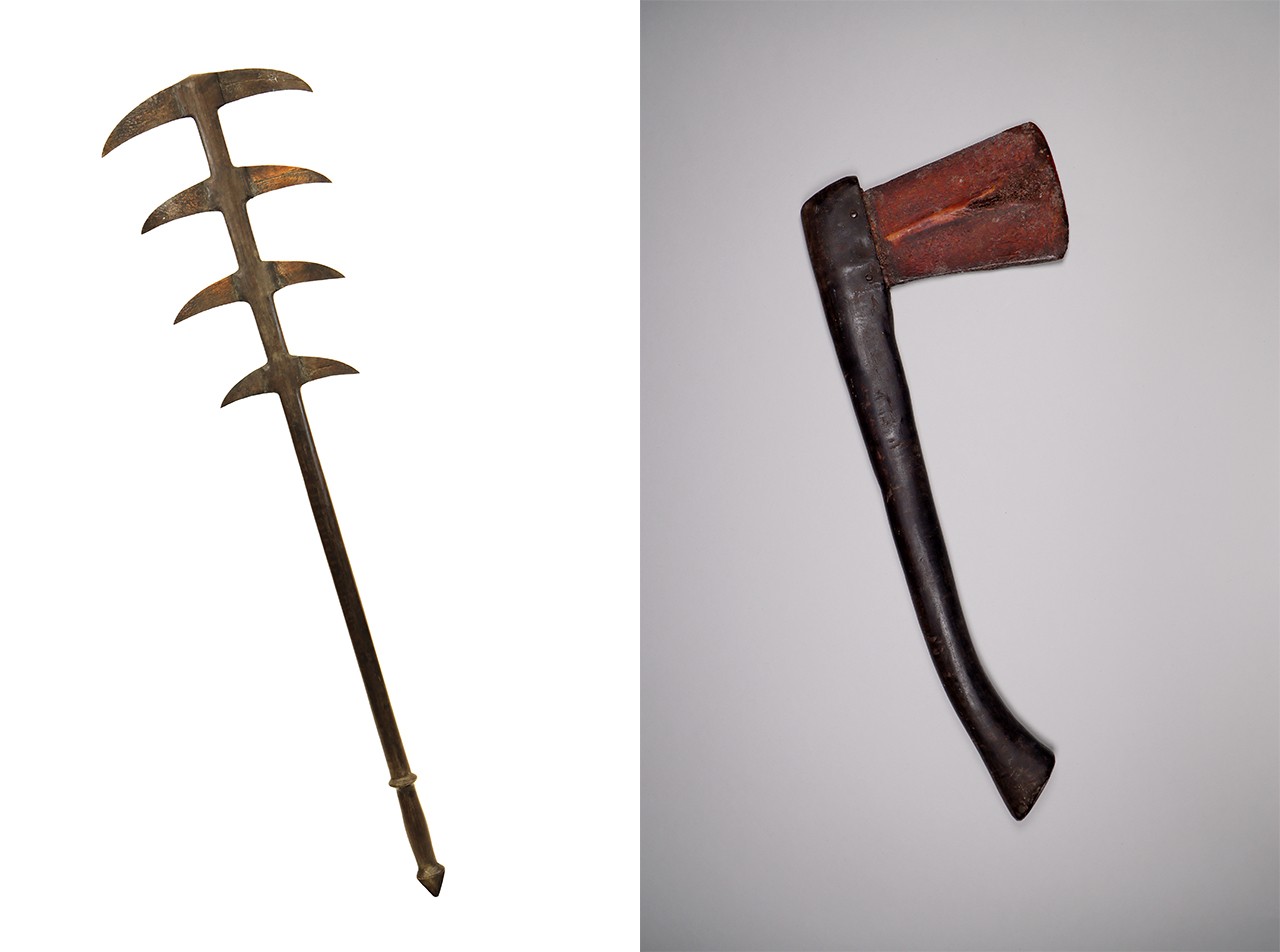 |
Club, 20th Century
Wuvulu Island, Manus Province, Papua New Guinea, Melanesia
Wood and turtle carapice; 51 × 14 × 2 in.
2015.11.1
Anonymous Donor |
Hatchet, 20th Century
Wuvulu Island, Manus Province, Papua New Guinea, Melanesia
Wood and turtle carapace; 15 7/8 × 6 3/16 × 7/8 in.
2021.7.48
Anonymous Loan |
Turtle-y Enough for the Turtle Club
Some of the earliest pieces of evidence that Wuvulu was culturally Micronesian instead of Melanesian were found in the objects on the island. Shark tooth blades similar to those featured in another Bowers Blog post on Gilbert Islands knives were catalogued in Wuvulu in the 19th century. European curators interested in finding more material connections between Wuvulu and Micronesia incited a collecting frenzy in traders coming to the islands. The high demand for traditional tools was met with entrepreneurial spirit by the islanders. Research has shown that many Wuvulu turtle carapace tools in museum collections were well past their prime in terms of use before being traded to Europeans for new metal tools and other objects that were difficult to find on the island. There is no visible evidence of use on the blade of the Bowers’ axe, and the shape of the blade is somewhat atypical among turtle carapace axes, however, it does share some characteristics of traditional Wuvulu turtle carapace tools such as the blade being secured with iron nails that were acquired through trade. Similar examples of fighting clubs to the above have been determined to have been created in the late 20th century for sale, but more research is needed to determine if this piece is authentic.

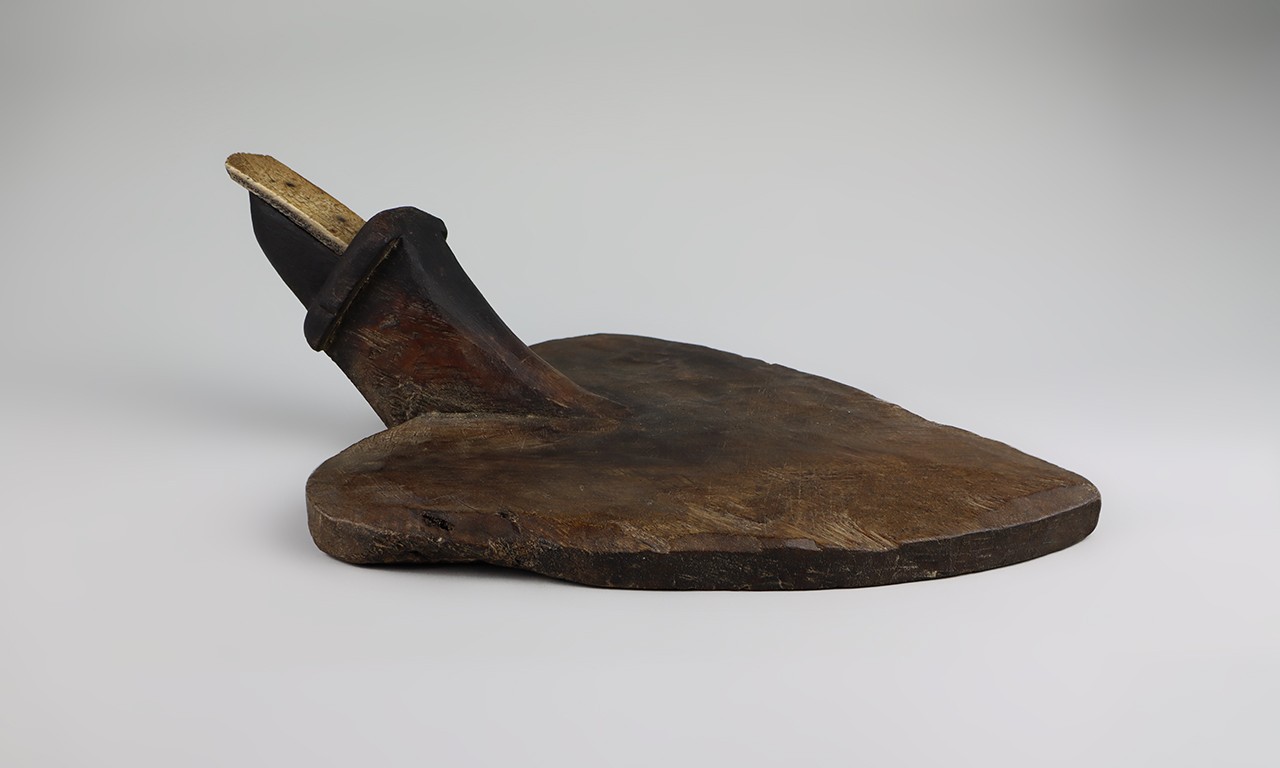 |
Coconut Grater, 20th Century
Wuvulu Island, Manus Province, Papua New Guinea, Melanesia
Wood, bone and metal; 17 1/2 × 12 × 6 in.
2021.7.30
Anonymous Loan |
From Wuvulu with Love
Coconut grating stools are employed throughout the Pacific with strikingly similar designs historically used in Africa and throughout Southeast Asia as well. The user sits on the seat facing an arm topped what is now generally a metal blade but is in the case of this grater made with bone. Coconuts are split in half, and then the blade can be used to scrape out the white flesh of coconuts into a bowl. Perhaps the most striking form of coconut grating stool is a squat saddle-shaped seat hailing from Nukuoro in the Caroline Islands. On Wuvulu coconut graters tend to have flat seats and no legs. Most other examples in museum collections also have a squarish shape, giving them the overall impression of a shovel with a shortened shaft. The shape of this grater’s seat appears to be unique in that it is heart-shaped when seen from above.

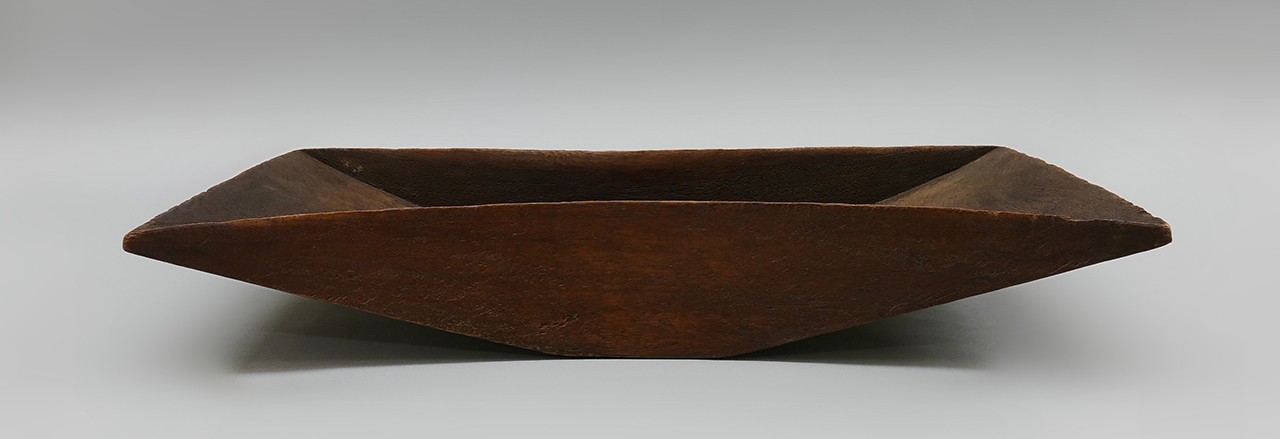 |
Coconut Milk Bowl (Apia Nie), early to mid 20th Century
Wuvulu Island, Manus Province, Papua New Guinea, Melanesia
Wood; 3 7/8 × 22 1/2 × 12 5/8 in.
2018.13.18
Gift of Anne and Long Shung Shih |
Simple Elegance
This bowl or apia nie was designed for the sole purpose of extracting coconut milk. After being deshelled and grated with a grater like the one featured above, the fibrous meat of the coconut is wrung out over these bowls to collect their milk. As is characteristic of Micronesian art, this bowl—carved from a single piece of wood—features a minimalist aesthetic. Though the refined design of these bowls might lead one to believe that they were reserved only for Wuvulu’s elite, their use was widespread and on a daily basis.
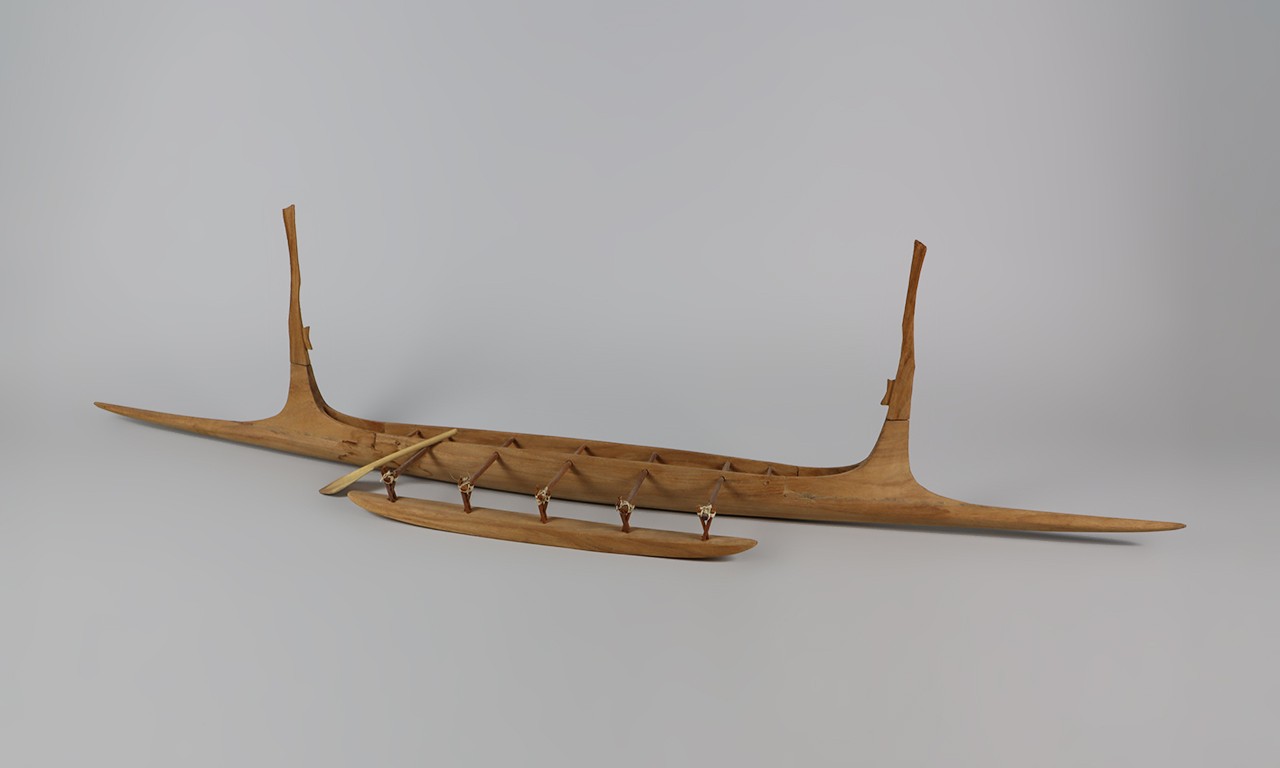 |
Model Canoe, 20th Century
Wuvulu Island, Manus Province, Papua New Guinea, Melanesia
Wood; 12 1/8 × 50 1/4 × 6 7/8 in.
2021.7.49a,b
Anonymous Gift |
Small Boat Sailing
Canoes from Wuvulu and its neighboring island of Aua are called wa. Featuring outriggers, a sleek, pointed profile, and equally pointed vertical spurs on both their prow and stern, there are no canoes quite like them anywhere in Oceania. Wa are carved from breadfruit trees in multiple pieces and put together with complex joinery rather than caulking. They can vary greatly in size from one person vessels just over 10 feet that are intended for fishing to enormous 60-foot-long ships intended for voyaging by as many as twenty individuals. In some cases, these canoes could be lashed together with their outriggers facing outwards and covered with planks and mats to create a temporary living space. Model canoes such as the above example were traditionally made almost everywhere that actual canoes are made. Like the canoes themselves, models from Wuvulu vary greatly in terms of size and scale. This example’s outrigger features five booms, but some have as many as twelve. Some canoe models also feature the pointed spurs of the full-size canoes while other, possibly later examples, tend to have the bulkier, flat-topped spurs seen here.
Text and images may be under copyright. Please contact Collection Department for permission to use. References are available on request. Information subject to change upon further research.







Comments